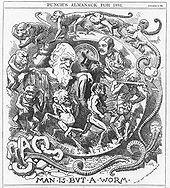Despite repeated bouts of illness during the last twenty-two years of his life, Darwin's work continued. Having published On the Origin of Species as an abstract of his theory, he pressed on with experiments, research, and writing of his "big book". He covered human descent from earlier animals including evolution of society and of mental abilities, as well as explaining decorative beauty in wildlife and diversifying into innovative plant studies.
Enquiries about insect pollination led in 1861 to novel studies of wild orchids, showing adaptation of their flowers to attract specific moths to each species and ensure cross fertilisation. In 1862 Fertilisation of Orchids gave his first detailed demonstration of the power of natural selection to explain complex ecological relationships, making testable predictions. As his health declined, he lay on his sickbed in a room filled with inventive experiments to trace the movements of climbing plants. Admiring visitors included Ernst Haeckel, a zealous proponent of Darwinismus incorporating Lamarckism and Goethe's idealism. Wallace remained supportive, though he increasingly turned to Spiritualism.
The Variation of Animals and Plants under Domestication of 1868 was the first part of Darwin's planned "big book", and included his unsuccessful hypothesis of pangenesis attempting to explain heredity. It sold briskly at first, despite its size, and was translated into many languages. He wrote most of a second part, on natural selection, but it remained unpublished in his lifetime.
His evolution-related experiments and investigations led to books on Insectivorous Plants, The Effects of Cross and Self Fertilisation in the Vegetable Kingdom, different forms of flowers on plants of the same species, and The Power of Movement in Plants. In his last book he returned to The Formation of Vegetable Mould through the Action of Worms.
He died at Down House on 19 April 1882. He had expected to be buried in St Mary's churchyard at Downe, but at the request of Darwin's colleagues, William Spottiswoode (President of the Royal Society) arranged for Darwin to be given a state funeral and buried in Westminster Abbey, close to John Herschel and Isaac Newton. Only five non-royal personages were granted that honour of a UK state funeral during the 19th century.
Darwin was perceived as a national hero who had changed thinking, and scientists now accepted evolution as descent with modification, but few agreed with him that "natural selection has been the main but not the exclusive means of modification". In "the eclipse of Darwinism" most favoured alternative evolutionary mechanisms, but these proved untenable, and the development of the modern evolutionary synthesis with population genetics and Mendelian genetics from the 1930s to the 1950s brought a broad scientific consensus that natural selection was the basic mechanism of evolution. Research and debate has continued within this frame of reference.


0 comments:
Post a Comment